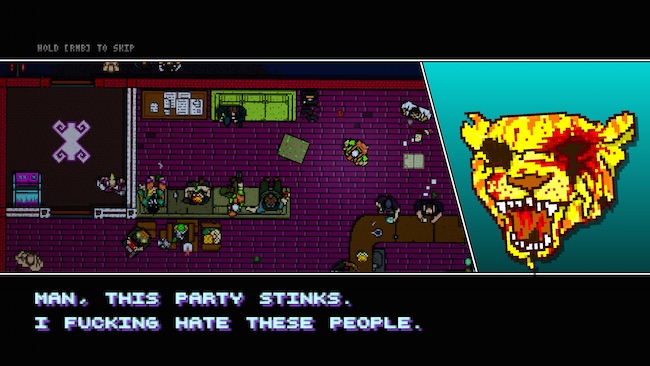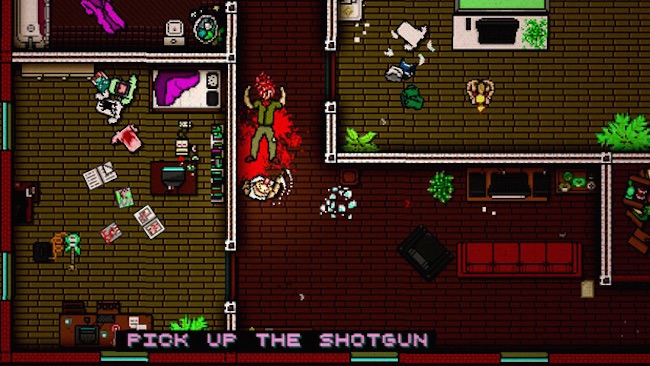
Hotline Miami is one of my favourite games of all time. In fact, it’s the only modern game that I sometimes go back to replay on occasion. From its surreal world and hyper-violent mechanics to the adrenaline-inducing design and brain-tingling soundtrack, it’s an experience that I almost want to label as flawless; if not for lack of a better word. Everything about the game simply functions in harmony, and it was for this reason I was feeling very nervous about a sequel. I didn’t feel the original vision needed anything added to it, and I was concerned that even slightest change could break what made it special in the first place. From what I had seen from the sequel prior, it left me feeling unenthused as just more of the same. However, what actually followed is a game that plays quite differently than I was initially expecting.

Hotline Miami 2 continues on from The Jacket’s interpretation of events, which is officially being accepted as canon. Although, when I say continue, I should clarify that the sequel is extremely anachronic in its delivery by taking place both before and after the events of the original. The sequel also has you playing from the perspective of nine different characters, of which some include a few familiar faces that will likely resonate well with the fans. The thing about the narrative structure this time around, however, is that it consistently switches character and time period with each new level – essentially, jumping all over the place. While Hotline Miami was deliberately vague and open to interpretation, it comes across as if the writers went out of their way to deliberately try and make the sequel unnecessarily convoluted.
Personally, I regard Hotline Miami the same way I do the movie SAW – with both being brilliant narrative pieces that could easily stand on their own without a sequel. In fact, I would even argue that both of them would have been better off without one. Basically, Hotline Miami 2 unfolds in a way that attempts to expand upon the existing story by showing us new perspectives on previous events, and by taking us all over the shop to try and tie together as many loose plot threads as the writers could pull. As a result, players are treated to a much more direct, dialogue-heavy adventure that attempts to answer a lot of questions. Overall, the story left me feeling conflicted because I genuinely enjoyed it, but I couldn’t shake the feeling it’s information I didn’t need and even hurts the vision of the original game. If anything, it leaves me thinking they should have maybe gone with a spiritual successor rather than a direct sequel.

In many ways, Hotline Miami 2 plays out in a similar fashion to its predecessor, with just a few small tweaks to refine the fundamental mechanics. There are few games that can make you sweat from adrenaline, and this is even more apparent in the sequel when everything is working in harmony. The problem, however, is the multi-character approach to level design as it more often than not gets in the way of those moments. The first game worked so well because it was relatively short and filled with smaller, sophisticated levels that you would need to rampage through in order to complete. As you moved forward, new masks would become available for special perks, ensuring that there was always a consistent feeling of progression. In Hotline Miami 2, the game constantly chops and changes, with each character being set up with a unique series of perks to unlock. In theory, this should have provided a newfound variety in how you play, but it actually felt more clumsy than innovative; damaging any true sense of progression as a result.
Something I take issue with is the mentality that bigger is better, which also happens to be a constant within Hotline Miami 2. First of all, the game is more than three times the length of its predecessor, which I personally felt was too long for this sort of experience. However, where I really draw an issue is with the size of the individual levels. In some cases, there are up to 5 large areas to clear out; which I often found more draining than exhilarating. You see, what makes these larger levels so problematic is that guns now play a much more prominent role than before. There are so many “snipers” hidden off-screen or in clear shot of a glass window, that it makes it almost infuriating to try and build the combo meter up at times. There is basically one tried method of success in these scenarios, and that’s cheesing enemies from around a corner. It feels cheap, and when the game forced me to play that way, I wanted to walk away.

I think at this point, it’s important to clarify that I still enjoyed the game – I just have a few major gripes. In truth, I’m a big fan of experimenting with new ideas, even if it doesn’t always work out so well. However, as a direct sequel, I struggle to embrace what they were trying to do. Had this been a different game, where they were free to push these new ideas further, I actually believe they could have worked well. For example, including unique enemies that require careful tactics to take down, or scenarios where you’re limited to a single weapon. There are also some interesting moments such as the sections that require non-lethal takedowns, as well as some incredibly surreal, tripped out gameplay towards the end. There just isn’t enough consistency, though, so while there are plenty of great moments scattered throughout, more often than not, the sequel contradicts the fundamentals of what makes Hotline Miami tick.
On the other hand, one thing the franchise has absolutely nailed yet again is the audio/visual presentation. I think it’s a strong part of what kept me invested as I really appreciate how they capture the over-the-top brutality of the gameplay in so much detail, but without taking it too far. The pixel art is simply divine, and I was also surprised to see that, while mostly subtle, there is actually a lot more detail in the environment and animations. Furthermore, the soundtrack is just as incredible as the first game, with a lot more variety this time around. There were plenty of techno-beats to drag me into the more adrenaline fuelled moments; but, what surprised me most about it were some of the more mellow tunes that really complimented somber moments of the game. The only unfortunate problem is that the game suffers from a lot more annoying bugs than the original. Often I saw enemies get stuck in doors, dogs spinning around in circles, and, once, I even got stuck in a wall after completing one of those exhausting over-sized levels. It really needs a patch!
 A lot of interesting, well-written dialogue
A lot of interesting, well-written dialogue
 The fundamental gameplay is as brutal as ever
The fundamental gameplay is as brutal as ever
 New perks are a lot of fun to experiment with
New perks are a lot of fun to experiment with
 Absolutely incredible visual and sound design
Absolutely incredible visual and sound design
 Deliberately convoluted narrative delivery
Deliberately convoluted narrative delivery
 Larger levels drain more than exhilarate
Larger levels drain more than exhilarate
 New ideas contradict fundamental principles
New ideas contradict fundamental principles
 Character progression feels very muddled
Character progression feels very muddled
 Bugs can often break the sense immersion
Bugs can often break the sense immersion
Hotline Miami 2 is a more than decent game, but it’s also one that sits squarely in the shadow of its predecessor. Where the first game was sophisticated in its design and left open to interpretation, the sequel feels deliberately convoluted, with many new ideas directly contradicting the fundamental principles of what makes Hotline Miami tick in the first place. When the narrative, mechanics, and level design are all working in harmony, you’ll experience some of the greatest moments of the series yet. However, more often than not, it falls on its face as it pursues the flawed mentality that “bigger is better.” Narratively speaking, the dialogue-heavy approach will likely engage established fans, but once it was over, I had to wonder if it was even necessary and whether it actually hurt the intentional vagueness of the original. At the end of the day, it’s more Hotline Miami and I think it’s worth playing if not for the soundtrack alone. It’s more clumsy than innovative, but the ideas here could become the foundation for a very worthy spiritual successor.
EDITOR NOTE: this game was supplied via our store wholesaler, and reviewed on PC across 17 hours of gameplay.











